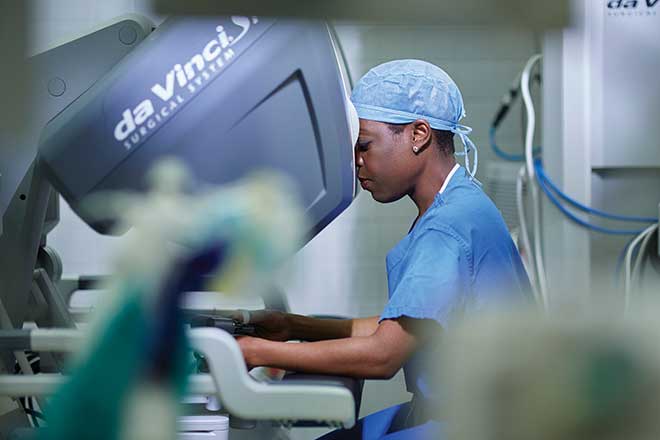When Marie Flaker, 85, was diagnosed with lung cancer earlier this year, her first reaction was fear. Her husband had passed away from the disease after struggling through rounds of chemotherapy and radiation. “She thought she was going to go down the same path,” says Flaker’s daughter, Deborah Sass. “But that wasn’t the case at all.” Thanks to cutting-edge robotic surgery offered through SLUCare Physician Group, Flaker faced a much better prognosis: a minimally invasive surgery and a few days in the hospital. That, plus a few weeks to heal, and she was back to her beloved water aerobics and line dancing.
Since the spring of 2015, SLUCare’s Dr. Melanie Edwards has performed robotic surgery using the Da Vinci Surgical System at SSM Health Saint Louis University Hospital. “For patients with early-stage lung cancer, it offers the best chance of long-term survival,” Edwards says. “This technology also is less invasive—the larger incisions with open surgery typically cause more pain and carry a higher risk of related complications.”
Elderly lung cancer patients, especially, might not have a surgical treatment option without the availability of minimally invasive surgery. “Many surgeons might hesitate to offer patients like Marie surgery because of concerns over their ability to tolerate the anesthetic and pain medications afterward and then return to normal function,” Edwards says. “These patients can better tolerate the robotic surgery, so by having it available, we’re giving them the option of a potentially curative operation.”
Another minimally invasive surgical methods is VATS (video-assisted thoracic surgery), which uses long, thin telescopes inserted through small incisions. While this also provides a less invasive approach than open surgery, it lacks the flexibility of movement and depth of precision of the robot, adds Dr. Keith Naunheim, a SLUCare thoracic surgeon who performs VATS at SSM Health St. Clare Hospital. The robot, in comparison, closely mimics human movement, with wrists that can move up and down and side to side, Edwards says. “The surgeons performing the surgery sit at a console and direct these arms through a 3-D video monitor,” she explains.
Because of the training time necessary to master robotic surgery, many lung cancer procedures in the U.S. still are performed using older methods and technology, Naunheim says. But fortunately for St. Louisans, SLUCare patients have access to both VATS and robotic surgery—the optimal situation since some cases are better suited to one over the other. In general, more complex cases are better suited for the robotic surgery, while more straightforward ones are better for the VATS, Naunheim says.
Of course, getting rid of the cancer was the No. 1 goal of Flaker’s surgery. But almost as important, Edwards says, was maintaining her quality of life. Making sure she’d be able to continue doing the things she loves was paramount. Now that she’s returned to her active lifestyle, things are good. “I live by myself, so it was important that I’m able to take care of myself,” Flaker says. “Being able to have the robotic surgery was a godsend.”
Pictured: SLUCare thoracic surgeon Dr. Melanie Edwards
Photo Courtesy of SLUCare Physician Group
SLUCare Physician Group offers a variety of surgical options, including VATs and robotic surgery, for lung cancer patients. For more information, call 314.977.4440 or visit slucare.edu/cardiothoracic.
